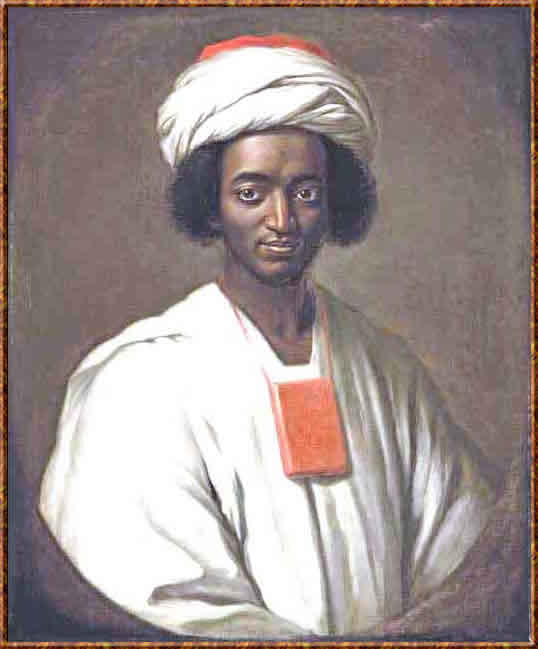
Ayuba Suleiman Diallo aka Job ben Solomon
(1701-1773)
Portrait by William Hoare (c.1707-72), 1733. Photo: Christie's Images Limited 2011. First British Portrait of a Black African Muslim and Freed Slave. It will be on display at the National Portrait Gallery in Room 15 from 20 January 2011.
See also Allan D. Austin, African Muslims in Antebellum America: A Sourcebook.
London. — The Qatar Museums Authority (QMA) and the National Portrait Gallery, London announce a cooperative agreement relating to the portrait of Ayuba Suleiman Diallo, painted by William Hoare of Bath in 1733. Following the purchase of the work by QMA at Christie’s in November 2009, the painting was the subject of export restriction, having been judged by the Reviewing Committee on the Export of Works of Art to be of outstanding importance to the history and culture of Britain. It was on this basis that the National Portrait Gallery expressed its strong interest in the painting.
QMA has now decided to lend the work to the National Portrait Gallery for a five year period. It goes on display at the Gallery from tomorrow Thursday 20 January 2011. QMA will support a programme organised by the Gallery to include the conservation of the painting, research and interpretation, a UK tour to include Leicester, Liverpool and the North-East, and an exhibition to visit Doha in 2013. As part of the programme, an intern from Qatar will spend time working at the National Portrait Gallery.
Roger Mandle, Executive Director of the Qatar Museums Authority, says: “I am delighted that we now are able to share such an important painting with audiences in Britain. Working with the National Portrait Gallery will allow the cultural, historical and religious significance of this portrait to be fully researched. This material can then be shared on an international basis.”
Sandy Nairne, Director, National Portrait Gallery, says:
« This is a good example of international cooperation between museums, which will extend the opportunities for people to understand the importance of Ayuba Suleiman Diallo. It is a portrait that sheds new light on cultural and intellectual exchanges in the first half of the eighteenth century. We are extremely grateful to all those people who were so enthusiastic about the appeal, and we will be following-up to return funds. I am very pleased that everyone will be able to see this fascinating painting on the walls of the Gallery and on tour. »
Temporary export bar for portrait of freed slave, Ayuba Suleiman Diallo, after £530,000 sale — Qatar's five-year deal with National Portrait Gallery means historic picture will return to UK after exhibition in Doha
The dignified, handsome face of Ayuba Suleiman Diallo, the earliest known British portrait of a freed slave, will remain in London at least for the time being after an agreement between the National Portrait Gallery and the painting's owner in Qatar.
The Qatar Museums Authority paid £530,000 for the painting at a Christie's auction, but the government imposed a temporary export bar after the sale because the work, by William Hoare of Bath, was seen as having great historic importance to the UK.
It shows Diallo as a devout Muslim, holding his Qur'an, which he had written himself from memory in London, and was apparently made at the request of his English friends despite his religious misgivings over being portrayed.
The NPG managed to match the price but the Qataris have reached a five-year deal to lend the work to the London gallery instead and abandoned the attempt to export the painting. The portrait will also be seen on a UK tour to Leicester, Liverpool and the north-east, and in 2013 will be the centrepiece of an exhibition in Doha, before returning to Britain.
Sandy Nairne, director of the NPG, said: “It is a portrait that sheds new light on cultural and intellectual exchanges in the first half of the 18th century.”
Diallo, known in England as Job Ben Solomon, was born around 1701 into a wealthy and scholarly family of Fulɓe Muslim clerics in Ɓundu (Senegal, West Africa). He was highly educated and spoke several languages. However the former slave owner and trader was captured by a rival tribe, humiliated by having his beard shaved, and enslaved. He was rescued from a tobacco plantation in Maryland by Thomas Bluett, an English lawyer and missionary, and brought to England where he became a celebrity, meeting George II and the intellectuals of the 1730s, and translating Arabic documents and inscriptions for Sir Hans Sloane, whose collections would become the nucleus of the British Museum.
The NPG launched a campaign last summer to buy the picture, and raised the full amount with more than £100,000 in public subscriptions plus £330,000 from the Heritage Lottery Fund, and £100,000 from the Art Fund charity. The donations and grants will now be returned.
Roger Mandle, the American director of the Qatar Museums Authority, said: “Working with the National Portrait Gallery will allow the cultural, historical and religious significance of this portrait to be fully researched. This material can then be shared on an international basis.”
However, there will inevitably be more tricky discussions about the painting. Having dropped their bid to export the painting, Qatar cannot apply again for a licence within 10 years — but the London museum would like to keep the picture permanently.
Maev Kennedy
The Guardian. January 19, 2011
